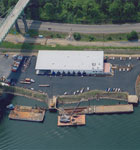
We started with pretty much an old blank warehouse. It was a very interesting project for me because it allowed us to do a few things we don’t typically do on a daily basis, as roughly 90 percent of our work is residential.
It looked like a cave the first time I went in. To transform the vacant warehouse into a functional business, we first tore down the existing walls of the warehouse, which previously housed large quantities of granite for more than 20 years. It was a totally different use than what you’d invite the public into.
The warehouse’s ceiling, steel girders, and beams were caked in dust and dirt. To clean the warehouse, my workers used high-pressure hoses and surface-sandblasting equipment. We also cleaned the facility’s few skylights, which were completely layered with black grime. In total, $28,500 worth of surface sandblasting and cleaning work was conducted. We then trenched the warehouse’s concrete floor.
The electrical and plumbing work was extensive. Energy-related work—which we [subcontracted] out—involved the complete revamping of the warehouse’s electrical systems, including panels and hanging lights. New electrical connections and systems were also installed to power the business’s huge 30’ x 20’ refrigeration units. It takes a lot of juice to run those things. Because moisture and water flow are constant in a florist shop, the plumbers we brought in created center drains throughout the new facility’s flooring for drainage. Additionally, bathrooms were installed on the facility’s first level for public use. In total $53,400 worth of plumbing and electrical work was conducted. We then installed new drywall ceilings and flooring, and the facility was painted inside and outside. Painting work totaled $44,220, and the installation of new floor came in at $29,070.
We then conducted two of our specialties—the building of all new shelving and the installation of cabinetry. These were part of a $102,900 office build-out. The shelving was produced in our factory, and the majority of the cabinetry was reused from the florists’s previous place of business. Because the client required a number of workstations and checkout counters, the facilitating of computers was another step in our build-out. Other aspects of the first-floor reconstruction—a job that cost nearly $2 million total—included a custom build-out for specialized usage within the warehouse.
The project represents a landmark, unique job for us. We completed the job in May 2011 at a cost of nearly $2.5 million. I view the entire project as a mass endeavor of engineering. ABQ


